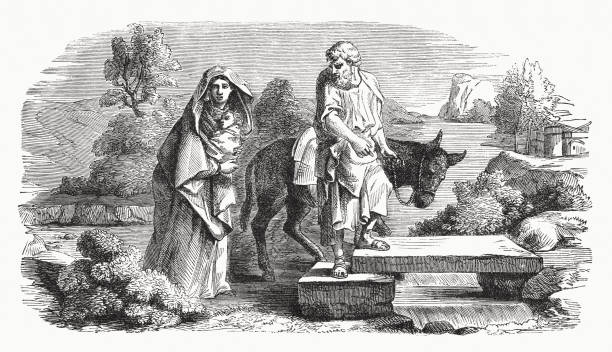A Sacred Journey Through the Heart of Egypt
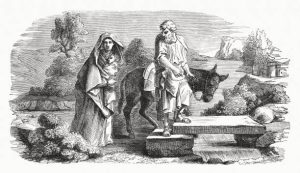
The Journey of the Holy Family to Egypt
Herod, the king, learned that his reign would end at the hands of a newborn child in Jerusalem. So, he ordered the slaughter of all male infants under two years old. The Virgin Mary, fearing for her infant son, was instructed by an angel, along with Joseph the carpenter, to flee to Egypt and remain there until they received news of Herod’s death. Herod, determined to kill the young child, was aware of his miracles. -An Imaginative Painting Edwin Long’s 1883 painting, “The Flight into Egypt,” vividly depicts the central figures: Saint Joseph, the Virgin Mary carrying the infant Jesus, as they enter the land of Egypt after fleeing Bethlehem.
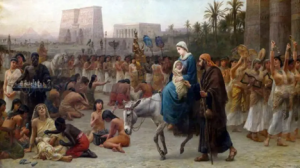
The Journey’s Path
A map illustrates the route of the Holy Family through Egypt.
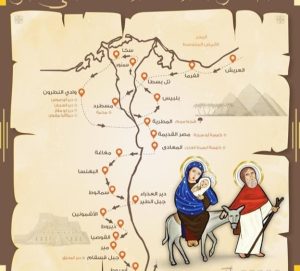
Giotto’s 14th-century fresco
Giotto’s 14th-century fresco, “The Flight into Egypt,” in the Scrovegni Chapel, Padua, Italy, offers a visual narrative of this journey. The arrival of Jesus in Egypt was a great blessing for its land and people. The Lord declared, “Blessed is my people Egypt.” The prophecy of Isaiah was fulfilled: “It shall be for the LORD an altar in the midst of the land of Egypt.” This prophecy was realized at the end of their journey when an angel appeared to Joseph in a dream, saying, “Arise, take the young child and his mother, and go into the land of Israel, for those who sought the young child’s life are dead.”
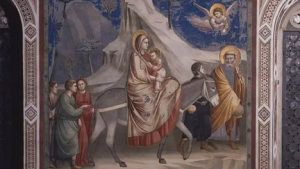
The gate of “Deir el-Maharraq”
The gate of “Deir el-Maharraq” monastery in Asyut marks the location of the cave where Mary and Jesus sought refuge during their journey.
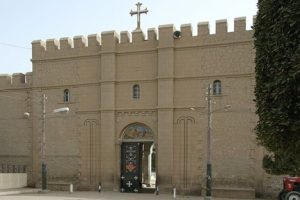
Tree of Mary
One of the most important areas to which the Holy Family headed was the Matareya area (Ain Shams or Heliopolis now ), where the Holy Family took shade under a tree known to this day as the “Tree of Mary”. -The Tree of Mary in Matariya, Cairo, is another important site on the Holy Family’s route.

Holy Family in Old Egypt
The Holy Family also visited old Egypt. However, they could not stay long due to the destruction of idols, which angered the governor of Fustat and wanted to kill the infant. Then The Holy Family refuge in a cave in Moqattam, they later built a church on this site, now known as “Abu Serga church”. -Abu Serga Cave is located in the Fortress Babylon area of ancient Egypt. This cave was the refuge of the Holy Family and later became the church of the same name.

Journey Through Wadi Natrun
Before heading to the Nile River, the Holy Family passed through a desert region near Alexandria known today as “Wadi Natrun”. It has been built in this area, the oldest and most important Monastery which is “Anba Bishoi” Monastery. -Monastery of “Anba Bishoy” in the Wadi Natrun area, one of the important points on the Holy Family’s Journey
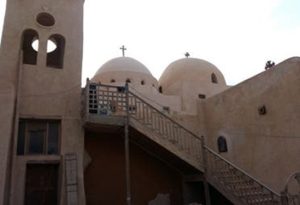
Jabal at Tayr
One of the places that was immortalized during this Journey is “Jabal at Tayr” in Minya, where the Monastery of the “Virgin Mary Jabal at Tayr” is now located, where the family settled in the cave that is now located in the ancient church there. -The Church of “Jabal at Tayr” Located in Minya Governorate in southern Egypt, this church houses the cave where the Virgin Mary and Jesus Christ sought refuge during their journey to Egypt, fleeing the Roman persecution
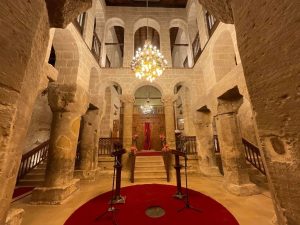
every place the Holy Family sought refuge in Egypt
As we saw, every place the Holy Family sought refuge in Egypt became a church or monastery. After the fulfillment of Isaiah’s prophecy, the Holy Family’s journey, which lasted more than three years, came to an end.

